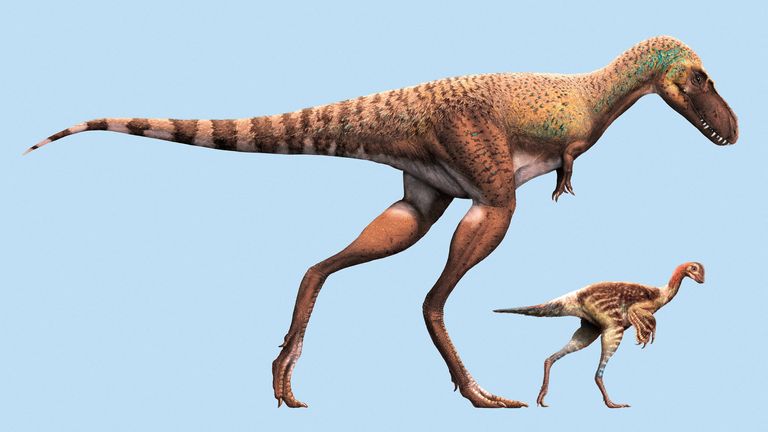Scientists have discovered a rare dinosaur fossil which they believe may shed new light on the eating habits of a close relative of the tyrannosaurus rex.
The gorgosaurus, from the meat-eating tyrannosaur family, was a smaller cousin of the fearsome T Rex and walked the earth several million years earlier.
Experts believe an adult gorgosaurus would typically have feasted on large plant-eating dinosaurs.
But scientists have now discovered a juvenile gorgosaurus fossil with the remains of two baby dinosaurs inside its stomach.
The fossil – which is 75 million years old – shows the gorgosaurus had eaten the hindlimbs of the feathered plant-eating dinosaurs, known as citipes, shortly before its death.
This, scientists say, could be evidence that, rather than hunting with adult dinosaurs in multi-generational packs, the diet of a gorgosaurus changed as it matured.
The fossil was discovered in Canada’s Alberta province
Dr Darla Zelenitsky, one of the lead scientists in the study, told the BBC the discovery was “solid evidence that tyrannosaurs drastically changed their diet as they grew up”.
She said: “We now know that these teenage (tyrannosaurs) hunted small, young dinosaurs.
“These smaller, immature tyrannosaurs were probably not ready to jump into a group of horned dinosaurs, where the adults weighed thousands of kilograms.”
Read more from Sky News:
Dinosaur and mammal discovered ‘locked in mortal combat’
New species of armoured dinosaur found on Isle of Wight
The fossil, the first tyrannosaur fossil with prey items preserved inside its stomach, was originally discovered in Canada’s Alberta Badlands in 2009.
But it was entombed in rock and took years to be prepared for study, which was published in the journal Science Advances.
The initial discovery was made by staff at Alberta’s Royal Tyrell Museum of Palaeontology, which spotted small toe bones protruding from the rib cage.

A drawing showing the size comparison of a juvenile gorgosaurus with a citipes
Dr Francois Therrien, dinosaur palaeoecology curator at the museum, and the other lead scientist in the study, said: “Adult tyrannosaurs were well-equipped for seizing and killing large prey, like duck-billed dinosaurs and horned dinosaurs.
“Their skulls and teeth were capable of withstanding the major torsional stresses associated with biting and holding onto large prey.
“In contrast, the weaker bites and teeth of young tyrannosaurs were ideal for slashing bites, not holding onto prey. They would have been well-equipped for hunting smaller dinosaur species and young dinosaurs.
“Young tyrannosaurs had blade-like teeth, lightly built skulls, relatively weak bites, long legs and appeared more ‘athletic’ than adult tyrannosaurs, which were very robustly built, had massive skulls, thicker teeth – often described as ‘killer bananas’ because of their shape – and powerful bites that allowed them to crush bones.”







